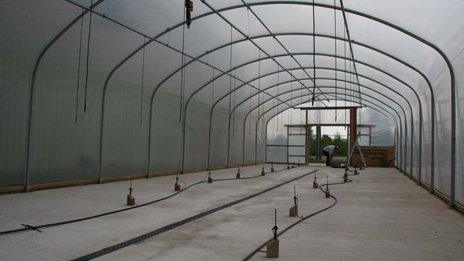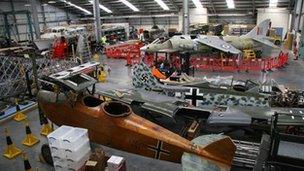Cosford team prepare for 'unique' Dornier 17 bomber
- Published

Two polytunnels, about 20m long (65ft), have been set up at Cosford. Hoses will spray the Dornier from above and below with a citric acid solution
Conservation specialists at the RAF Museum in Cosford, Shropshire, are preparing to take possession of a "unique" aircraft.
A German Dornier 17 bomber being recovered from the floor of the English Channel is the last of its kind and the pioneering techniques planned for its conservation are just as significant.
"It's a first for aircraft, as far as we know, but the approach was similar for the Mary Rose when that came up from the Solent," Tim Wallis, head of the Michael Beetham Conservation Centre said.
Rather than submerge the wings and fuselage in large and expensive tanks, they plan to spray them with water and then a combination of citric acid and sodium hydroxide in an attempt to halt the corrosion.
The chemicals will be collected, analysed and then recycled.
A series of hoses have already been installed inside two polytunnels beside one of the main hangars.
The hoses can be extended or offer different spray patterns to coat the aircraft.
Metal cage
The "ground-breaking" technique has been developed alongside scientists at Imperial College in London, who have tested samples from the Dornier with different chemicals.
Before technicians can start work on the aircraft, however, it first has to be recovered from the sea bed.
A metal cage is being carefully constructed around the Dornier and it is expected to be raised in the next three weeks.
Once on the surface the project will move quickly to prevent further damage.
Al McLean, curator at the RAF Museum, said that in the eight hours the barge carrying the aircraft is expected to take to get to port, it is hoped both wings will be removed from the main fuselage.
He said the aircraft would then be covered in a special gel to prevent it from drying out, before being taken by low-loaders to Cosford.
Once there, the conservation effort will begin in earnest.
Stabilising the various metals - aluminium alloys, steel, copper and brass - and stopping further corrosion is expected to take 15 to 18 months.
Corrosive seawater
Having lain under the channel for the last 70 years, experts know some parts of the Dornier have already been lost to the corrosive seawater.
That is on top of the damage to the aircraft when it crashed into the sea more than 70 years ago.
It is believed the Dornier was shot down on 26 August 1940 by a Boulton Paul Defiant, which was produced just down the road from Cosford, in Wolverhampton.
Mr Wallis said there was, however, some hope for the team.
He said the aircraft, produced early in the war, was likely to have been built from thicker grade and better quality materials than later aircraft.
A handful of parts of the aircraft are also known to be in fair condition. Sonar results, for example, show that the aircraft's tyres are still inflated.
Mr Wallis said the initial plan was to display the Dornier at the RAF museum in Hendon in its current condition.
"We think people will be fascinated to see the aircraft as it was on the seabed," he said.
In the long term, however, he said the museum had not ruled out restoring it either in part, or fully.

Teams at Cosford are also restoring a WWI biplane and Hawker Siddeley Kestrel
Rare aircraft
If it is to be restored, it will almost certainly return to Cosford, which undertakes all major work for the RAF museums.
It is regarded globally as a centre for excellence in its field and is used to handling rare aircraft.
A team from the centre is currently in Kuwait restoring a Spitfire that is due to take centre-stage at the British Embassy in time for the Queen's visit.
At Cosford itself, the team is also restoring a World War I German LVG biplane, believed to be only serviceable one its kind in the world.
A Hawker Siddeley Kestrel, one of only a handful produced, also lies in the hangar, alongside Wellington and Handley Page Hampden bombers.
Whatever the future for the Dornier, Mr Wallis said the museum was "wholly committed" to preserving this "hugely significant" aircraft.
- Published4 May 2013